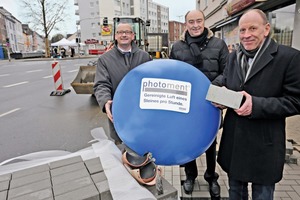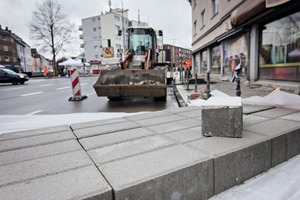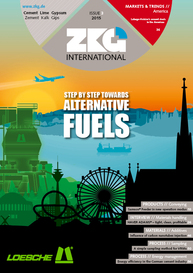Paving stones with Photoment®
Together with Kronos in Leverkusen, STEAG Power Minerals developed the concrete additive Photoment®, which can break down the harmful nitrogen oxides in inner city atmospheres which suffer from traffic pollution. For the area in Bottrop, bvw Hamminkeln, a manufacturer of concrete blocks based in the lower Rhine region, produced the paving stones with Photoment®. According to independent calculations by the Technical University of Berlin, one of these stones removes around 48 µg of harmful NO2 from a cubic meter of air in one hour.
What to do about nitrogen oxides polluting our cities?
Almost everyone has learned in the current press about the problem of nitrogen oxides in our inner cities. The occurrence of nitrogen oxides, but also e.g. of particulate matter and ozone, is registered permanently by several measuring stations. For Germany, the Federal Environment Agency (UBA) gathers these data and publishes an air quality report annually. The evaluation is usually made according to the limit values set by the German Federal Immission Control Act (BImSchG), which regulates the protection of humans, animals, plants, soil, water, air and cultural assets. So far, for nitrogen oxides the values developed in 1999 apply. As requested by the European Commission, the German Federal Government amended this act in 2010 with the 39th Ordinance Implementing the Federal Immission Control Act (39. BImSchV).
According to §3 of 39. BImSchV, the hourly limit value of 200 µg/m3 NO2 should not be exceeded more than 18 times per year and an annual mean limit value of 40 µg/m3 NO2 has to be complied with. These requirements become obligatory after a 5-year transitional period, that is 01.01.2015, and penalties for non-compliance will be imposed by the European Commission.
But what exactly are these nitrogen oxides and where do they come from? The main emission sources of nitrogen monoxide (NO) and nitrogen dioxide (NO2) – often collectively referred to as nitrogen oxides (NOx) – are road transport and combustion processes in households, industry and the energy sector. From a chemical point of view, both air pollutants undergo equilibrium reactions with the atmospheric oxygen, forming a cause for ozone and thus for the well-known summer smog. Regarding the values in the air quality report 2012, it is obvious that, in particular cases, already the amount of the background exposure could reach an annual average limit up to 35 µg/m3 of NO2 in some parts of German cities. The (preliminary) air quality report 2013 does not come up with better news, either: At least at 56 % of the measuring stations located near traffic sites the annual limit will be exceeded, presumably even at ca. 70 % of measuring stations after completion of the evaluation. Quite clearly, there is a strong need for further actions. Generally, for this purpose cities and municipalities propose technical measures in their air quality plans.
One of these measures could be the application of photocatalysis or, more precisely, of photocatalytically active roof surfaces, facade coatings and/or paving stones. They have the ability to remove nitrogen oxides from the ambient air. In comparison to other measures (such as speed reductions and other traffic restrictions), photocatalysis features a similar reduction potential devoid of economic constraints.
For example, photocatalytic paints could be applied to house facades and noise barriers or photocatalytic paving stones could be laid on pavements and in pedestrian zones. Also the direct application on asphalt, and thus in the immediate proximity to cars as main emitters, is being investigated and evaluated intensively at the moment. Altogether, a comprehensive coverage of inner city spaces with the above-described measures could make a significant contribution to clean breathing air.



